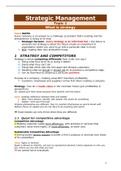Samenvatting
Summary and Exam Questions with answers Strategic Management
- Instelling
- Universiteit Antwerpen (UA)
This documents contains every exam question spoken about in class with the answers to them. It also includes all the cases with other examples that will give you higher distinction on your exam. 90 pages with a summary of the most important models and examples. This class was given by Prof. Dr. Pet...
[Meer zien]



